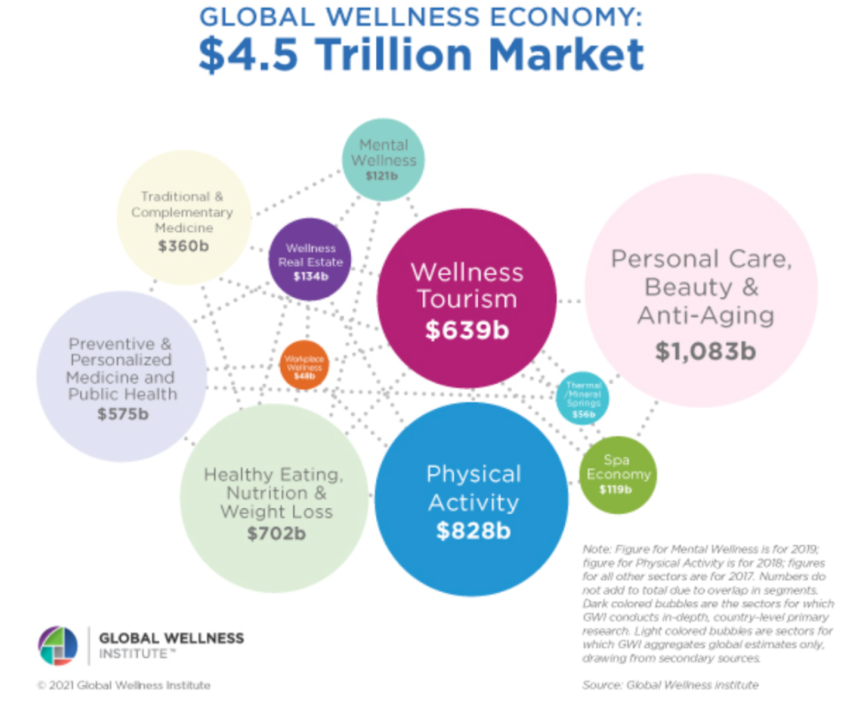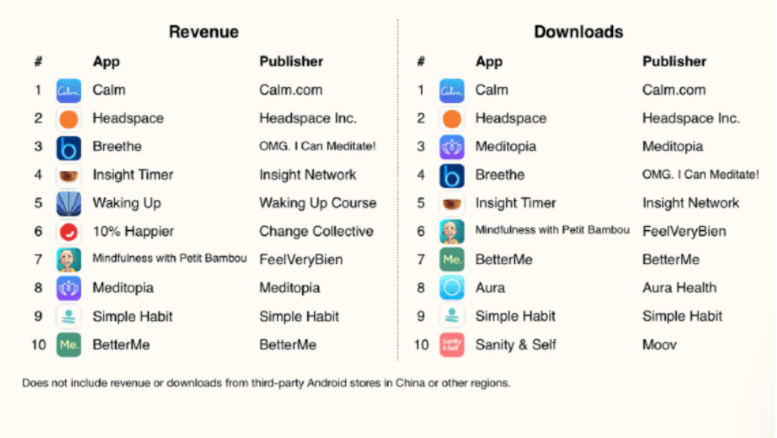In these uncertain times, we are faced with new challenges to our wellness and lifestyle, with our physical and mental health affected by stress, anxiety, lack of focus and fitness, sleep deprivation and disorders, and a host of many more issues.
1. Introduction
The Global Wellness Institute has defined the concept of wellness as the active pursuit of activities, choices and lifestyles that lead to a state of holistic health. However, the concepts of wellness and wellbeing are slightly different. Wellbeing encompasses more than just physical health. Wellbeing is also the cultivation of healthy, strong relationships, of practising mindfulness, and a state of happiness and being comfortable, of giving of one’s self.
The rise of selftracking is an exciting development that can contribute to people being able to take charge of their own health and wellbeing. Other than that, cities are playing an increasing role in the promotion of wellness amongst their inhabitants. This is the new age of prevention: with companies like RoundGlass aiming to help people find balance, and the rise of meditation apps, it is now more accessible than ever to take personal wellbeing seriously.
2. Defining Wellness and Wellbeing
Defining wellness and wellbeing is critical for our times.
What does wellness mean?
One of the leading resources on global health, the World Health Organization, defines wellness as a state of complete physical, mental and social wellbeing and not merely the absence of disease and infirmity. Today, all dimensions of wellness are interrelated and crucial to a fulfilling life.
What does wellbeing mean?
Wellbeing is defined by the Oxford English Dictionary as “the state of being comfortable, healthy, or happy”.
Thus, it is easy to see how the modern definitions necessarily involve some “holistic element”. Holistic wellness will be defined below.
3. The business of wellness and wellbeing
Wellness and wellbeing have become measurable, opening the door to a new wellness digital economy and what we call Wellness or Wellbeing-as-a-Service (WaaS). This thriving sector attracted more than $2.2 billion in investment in what is now called WellTech. The market is anticipated to be valued at USD 4,377.95 millions by 2027. This sector is part of the growing $4.5 Trillion Wellness business, driven by the pursuit to merge with the healthcare industry, into a whole new market.
When we speak about wellness industry we need to consider the following sectors and economics and research by the Global Wellness Institute:
1. Personal care, beauty and anti-aging a $1.083 Trillion ecosystem;
2. Physical activity that represents a $828B Trillion ecosystem;
3. Wellness tourism – $639B;
4. Healthy, Eating, nutrition and weight loss – $702B;
5. Preventive and personalised medicine and public health;
6. Traditional and complementary Medicine – $360B;
7. Mental wellness – $121B;
8. Wellness real estate $134B;
9. SPA economy $119B;
10. Workplace wellness $43B;
11. Thermal / Mineral $56B

Some extra data important to consider before we start:
There are more than 2,500 meditation mobile applications have been launched since 2015;
Consumers Grabbing Hold of Their Health and Wellness Drives $450-Billion Opportunity.
4. Top Meditation Apps 2019

The top 10 meditation mobile applications generated a revenue of $195 million last year. The leading apps, @calm, @Headspace and @InsightTimer, lead the market, especially in the USA. US app users invest 63% of their total time spent on InsightTimer. Other main apps are Calm and Headspace. These have a strong business model and valuations of unicorns or close.
As the financial data at hand shows us, wellbeing and all wellness sectors are the next big industries to be disrupted by tech.
5. Why the Business of Meditation and App?
There are several reasons for this sudden surge of interest in meditation apps. The ease of access means that while people are still using these tools primarily for meditation, they are increasingly useful to create a moment of peace or of self-centring in the daily chaos of ever-changing lockdown regulations and the disruption of our lives. In these uncertain times where human connections have been severely disrupted, these apps can be a strong and effective way to connect with ourselves in a meaningful way, and help to reduce anxiety and the fatigue brought on by constant vigilance and social distancing.
Statistics from the US provide evidence on how Americans practise meditation on a regular basis to relax and unwind: the US is the prime market for meditation apps.
Other interesting statistics include an 800% surge in children practicing meditation in the past eight years, and the formation of a gender gap: women are shown to meditate more regularly than men. Moreover, smartphone and digital device users are preferring varied monthly subscription plans depending on timings.
Measuring wellbeing, wellness, happiness is more and more relevant because it is a better personal, social, professional and economic indicator and the next frontier of the health of a community, country, a company or a business. That is why the concept of Wellbeing-as-a-Service (WaaS) is a hot topic now.
The wellness wellbeing digital economy is not solely granted by new, disruptive technologies; but by what lies behind them: the human wellness factor.
6. Holistic Wellness
Understanding the concept of holistic wellness requires one to look at health as a dynamic and multidimensional concept. According to the Global Wellness Institute, “health as a continuum that extends from illness to a state of optimal wellbeing”.
On one end of the spectrum, patients with poor health engage the medical system, seeking help for their ailments. On the opposite end, people focus on prevention and improving the quality of their lives proactively, driven by self-responsibility.
The origins of holistic wellness are ancient, as the main tenets of wellness can be traced back to the ancient civilizations of Greece, Rome, and Asia.
3,000 – 1,500 BC: Ayurveda is holistic and it aims to create harmony between the body, mind, and spirit. It operates according to the principle that maintaining a balance in one’s life contributes to a long, healthy life. Yoga and meditation, as well as other mind-body-spirit practices also originated from India. From India also originated mind-body-spirit traditions such as yoga and meditation, which are increasingly practiced in modern, Western cultures.
3,000 – 2,000 BC: Traditional Chinese Medicine (TCM) is one of the oldest systems of medicine in the world, with a holistic approach to wellness and health. Therapies that evolve out of TCM – such as acupuncture, herbal medicine, qi gong, tai chi – are not only still in practice, but are also increasingly being integrated into Western medical practices.
500 – 300 BC: Ancient Greek physician Hippocrates is considered to be the father of Western medicine; he was the first to focus on prevention of illness instead of simply the cure.
Further developments – more current times:
According to the Wellness Institute Whitepaper, in the 19th century, “new intellectual movements, spiritual philosophies, and medical practices proliferated in the United States and Europe. A number of alternative healthcare methods that focus on self-healing, holistic approaches, and preventive care – including homeopathy, osteopathy, chiropractic, and naturopathy – were founded during this era and gained widespread popularity in both Europe and the United States”. These were based on the ancient ideas which were explained above.
In terms of how wellness was popularized in the 20th century, it was due to the work by physician Halbert L. Dunn, called High-Level Wellness (published in 1961). His ideas were then expanded upon by Dr. John W. Travis, Don Ardell, Dr. Bill Hettler, and others. These fathers of the wellness movement created the world’s first wellness center, developed the first university campus wellness center, and established the National Wellness Institute and National Wellness Conference in the United States.
The Wellness Institute explains that wellness has certain characteristics. The most important ones listed by the organization are:
1. Wellness is multidimensional
2. Wellness is holistic
3. Wellness changes over time and along a continuum
4. Wellness is individual, but also influenced by the environment
5. Wellness is a self-responsibility
It is clear that wellbeing is about more than just physical health. According to the Institute, there are at least 6 types of wellbeing. These are:
1. Physical: A healthy body through exercise, nutrition, sleep, etc.
2. Mental: Engagement with the world through learning, problem-solving, creativity, etc.
3. Emotional: Being in touch with, aware of, accepting of, and able to express one’s feelings (and those of others).
4. Spiritual: Our search for meaning and purpose in human existence.
5. Social: Connecting with, interacting with, and contributing to other people and our communities.
6. Environmental: A healthy physical environment free of hazards; awareness of the role we play in bettering rather than denigrating the natural environment.
7. The Opportunities Around Quantified Self, Datafication and Personal Wellness
One important thing for society in a world of technology and fast growing acceleration are the opportunities around quantified self, datafication, and personal wellness.
The quantified self refers both to the cultural phenomenon of self-tracking with technology; “self-knowledge through numbers”.
History
Quantimetric self-sensing was first used to sense and measure exercise and dietary intake in 2002:
“Sensors that measure biological signals, a personal data recorder that records. Lifelong videocapture together with blood-sugar levels, correlate blood-sugar levels with activities such as eating, by capturing a food record of intake”.
The “quantified self” or “self-tracking” are modern labels. The term “quantified self” seems to have been coined in San Francisco by Wired magazine editors Gary Wolf and Kevin Kelly in 2007 as “a collaboration of users and tool makers who share an interest in self knowledge through self-tracking”. Later on, Wolf promoted the movement on TED, and also launched the first international self tracking conference in May 2011, in Mountain View, California.
Wolf’s idea was that companies who have large amounts of our data could use that as a force for good; and give people new ways to deal with medical problems, help sleep patterns, and improve diet.
Benefits
As described by a paper from the Schumacher Institute, a good example of how self-tracking can be beneficial for the individual is shown by those who track in order to manage a chronic illness, such as type 1 diabetes.
Described by researchers as being “somewhat unique among chronic conditions in that it’s very data-intensive”, type 1 diabetics need to use technology to track and log their blood glucose levels on a regular basis.
Scientist Hayley McBain claims that other chronic illnesses, such as COPD and heart failure, also “respond positively to self-tracking methods, which results in the decrease in hospital admission rates for those who regularly selftracked”. This is important, as it gives people the power over their own health outcomes.
The writer for the Schumacher Institute explored his personal experience with selftracking in the context of diabetes:
“I have personal experience of the individual benefits that self-tracking can have on my management of the condition, especially in the context of information exchange via the internet.
Gathering data of my blood sugar in relation to factors such as exercise, food intake, and timings of meals allows me to note down values which I would like to adjust.
This process has been made faster and more constructive by the use of online forums, such as on the website Reddit or Diabetes.co.uk, where questions can be posed to other type 1 diabetics complete with necessary information and figures that are specific to me. In contrast with the process of booking an appointment with an endocrinologist, this process is far more convenient and allows for the ‘fine-tuning’ of the multitude of variables that must be considered when living with this disease. This is an example of what Briggs would describe as the empowering effect of the quantified self, as instead of being confined to the rigid and removed world of the public health sector, patients are able to take ownership of their condition by treating it with precise and personalised methods”.
Other uses
Despite self-tracking being seemingly an individual endeavour, it is becoming a more and more socialised phenomenon as social media platforms allow for users to share data, methods, and results. Scientist Btihaj Ajana explained the reasons for this: these media platforms work “as a source of encouragement and acknowledgement, which are effective motivators for people to continue to self-track; to enhance expertise via the wisdom of the crowd”.
One example can be the cycling and running tracking app Strava. It encourages competition between users. According to Jesse Couture from University of British Columbia, “Strava can be a source of motivation and entertainment for its users, and even help to establish or strengthen social networks, but the platform also invites users to adopt and adapt to technologically-mediated surveillance strategies that encourage and reward displays of bodily self-discipline”.
8. Why Cities and Governments Need to Focus on Wellness, Wellbeing
It is not difficult to see why governments should focus on the wellbeing of their citizens. The whole of the healthcare system relies on that, and promoting prevention of illness can positively affect healthcare capacity. What about cities?
Health and well-being in the cities is a critical matter: “it is a public health issue that will result in widespread human distress and enormous financial costs in the long-run if we do not take the appropriate measures in the short term”.
According to the King’s Fund Whitepaper, in the case of UK:
• Elected mayors and other city leaders have “soft powers beyond their formal responsibilities that they can use to drive pro-health policies”.
• Compared with other countries, “the fiscal regime in the UK is highly centralised, with more than 90 percent of tax revenue being raised at the national level. Policy-makers should explore the case for giving cities further fiscal and regulatory freedoms to enable them to tackle population health challenges more effectively”.
Case study: environmental wellbeing / climate change
There is an increasing role of cities in promoting environmental sustainability. As the King’s Fund argues, cities such as New York, London, Copenhagen, Paris, Barcelona, Oslo, Stockholm and Vancouver have committed themselves to carbon reduction targets, which are more extensive than the Paris climate accord ones.
And whilst the US national government decided to pull out of the Paris agreement, almost 250 US cities have agreed to continue honouring the commitments. It is clear that the actions cities can take to reduce greenhouse gas emissions also confer health benefits for the citizens.
9. Case study RoundGlass
A case study for a company that is in the holistic wellness space, can be done using the example of RoundGlass. RoundGlass is a global Wholistic Wellbeing* company founded in 2014, dedicated to empowering and enabling people on their personal wellbeing journey.
Wholistic wellbeing is a concept centred around the words: whole + wellbeing = wholistic wellbeing. The mission of RoundGlass is to “inspire people to embrace a life of Wholistic Wellbeing to create a happier, healthier, and more joyful world” and “to transform the prevailing reaction-based approach in the healthcare world to one that’s proactive, focused on prevention in addition to treatment”.
The full RoundGlass experience consists of various initiatives, all of which are described below:
• RoundGlass Meditation Collective: A new method to life through meditation leads to more harmony, clarity, confidence, and joy.
• RoundGlass End of Life (EOL) Collective: Turning one of life’s taboo conversations into a deeply engaging, insightful, compassionate, and empowering experience.
• RoundGlass Sustain: Bringing India’s rich biodiversity to a global audience in a media-rich digital encyclopedia of the species and ecosystems.
• RoundGlass Sports: Investing in the future of Indian sport through world-class coaching and talent development and a fully integrated Wholistic Wellbeing approach.
• RoundGlass Foundation: Driving Initiatives to bring sustainable improvements in wellbeing across all aspects of life in villages and underserved communities.
Location
Most of their work is currently being done in India. Yoga and Ayurveda have been benefitting Indian people since ancient times, but over the years these wholistic concepts have gained more popularity in the Western world. RoundGlass is currently working on executing the model village projects in Punjab and after their successful implementation, we plan to go pan-India.
Teachers
RoundGlass services offer a range of wellbeing experts and meditation and mindfulness teachers offering classes and courses in physical, mental, and spiritual wellbeing. More about teachers and their stories can be found here.
Success stories
RoundGlass are working with 90 villages in Punjab and plan to expand to 150 villages. The initiatives that they implemented in these villages range from creating football academies, installing solar panels, and establishing proper waste management mechanisms, to setting up Learn Labs in schools.
In a village near Mohali, RoundGlass’ sports programme has helped significantly curb drug addiction. Involving young people in sports such as football has given them something to work on and perfect, which contributed to creating a more widespread sense of purpose in the community.
10. Conclusion
The Wellness Digital Economy is growing. Even though holistic wellness has its roots in ancient times, it is currently going through a revival. With the rates of depression and anxiety rising in previous years, it is now vital that the appropriate wellbeing tools are at one’s disposal. The market has responded to the need: the meditation app boom has followed, alongside the trend of “the quantified self”. Furthermore, companies like RoundGlass are trying to create a new paradigm of prevention instead of simply curing illnesses. The idea is to transform the prevailing reaction-based approach in the healthcare world to one “that’s proactive, focused on prevention in addition to treatment”.
Sources:
Five ways that ESG creates value
Workplace Wellness and Employee Mental Health—An Emerging Investor Priority, Harvard Law School Forum on Corporate Governance. Posted by Andrea K. Wahlquist, Sabastian V. Niles, and Lauren M. Kofke, Wachtell, Lipton, Rosen & Katz
Mental Health and Employee Welfare: An Emerging ESG Concern
Wellbeing: the next disrupted industry by tech by @mircopasqualini https://link.medium.com/x2e3UxAHygb
Unhooking the Drama: Meditation App Statistics to Know in 2020
https://appinventiv.com/blog/meditation-app-statistics/
The Quantified Self
https://www.schumacherinstitute.org.uk/download/pubs/res/202002-The-Quantified-Self-Hadi-Sami.pdf

Dinis Guarda is an author, academic, influencer, serial entrepreneur, and leader in 4IR, AI, Fintech, digital transformation, and Blockchain. Dinis has created various companies such as Ztudium tech platform; founder of global digital platform directory openbusinesscouncil.org; digital transformation platform to empower, guide and index cities citiesabc.com and fashion technology platform fashionabc.org. He is also the publisher of intelligenthq.com, hedgethink.com and tradersdna.com. He has been working with the likes of UN / UNITAR, UNESCO, European Space Agency, Davos WEF, Philips, Saxo Bank, Mastercard, Barclays, and governments all over the world.
With over two decades of experience in international business, C-level positions, and digital transformation, Dinis has worked with new tech, cryptocurrencies, driven ICOs, regulation, compliance, and legal international processes, and has created a bank, and been involved in the inception of some of the top 100 digital currencies.
He creates and helps build ventures focused on global growth, 360 digital strategies, sustainable innovation, Blockchain, Fintech, AI and new emerging business models such as ICOs / tokenomics.
Dinis is the founder/CEO of ztudium that manages blocksdna / lifesdna. These products and platforms offer multiple AI P2P, fintech, blockchain, search engine and PaaS solutions in consumer wellness healthcare and life style with a global team of experts and universities.
He is the founder of coinsdna a new swiss regulated, Swiss based, institutional grade token and cryptocurrencies blockchain exchange. He is founder of DragonBloc a blockchain, AI, Fintech fund and co-founder of Freedomee project.
Dinis is the author of various books. He has published different books such “4IR AI Blockchain Fintech IoT Reinventing a Nation”, “How Businesses and Governments can Prosper with Fintech, Blockchain and AI?”, also the bigger case study and book (400 pages) “Blockchain, AI and Crypto Economics – The Next Tsunami?” last the “Tokenomics and ICOs – How to be good at the new digital world of finance / Crypto” was launched in 2018.
Some of the companies Dinis created or has been involved have reached over 1 USD billions in valuation. Dinis has advised and was responsible for some top financial organisations, 100 cryptocurrencies worldwide and Fortune 500 companies.
Dinis is involved as a strategist, board member and advisor with the payments, lifestyle, blockchain reward community app Glance technologies, for whom he built the blockchain messaging / payment / loyalty software Blockimpact, the seminal Hyperloop Transportations project, Kora, and blockchain cybersecurity Privus.
He is listed in various global fintech, blockchain, AI, social media industry top lists as an influencer in position top 10/20 within 100 rankings: such as Top People In Blockchain | Cointelegraph https://top.cointelegraph.com/ and https://cryptoweekly.co/100/ .
Between 2014 and 2015 he was involved in creating a fabbanking.com a digital bank between Asia and Africa as Chief Commercial Officer and Marketing Officer responsible for all legal, tech and business development. Between 2009 and 2010 he was the founder of one of the world first fintech, social trading platforms tradingfloor.com for Saxo Bank.
He is a shareholder of the fintech social money transfer app Moneymailme and math edutech gamification children’s app Gozoa.
He has been a lecturer at Copenhagen Business School, Groupe INSEEC/Monaco University and other leading world universities.






























